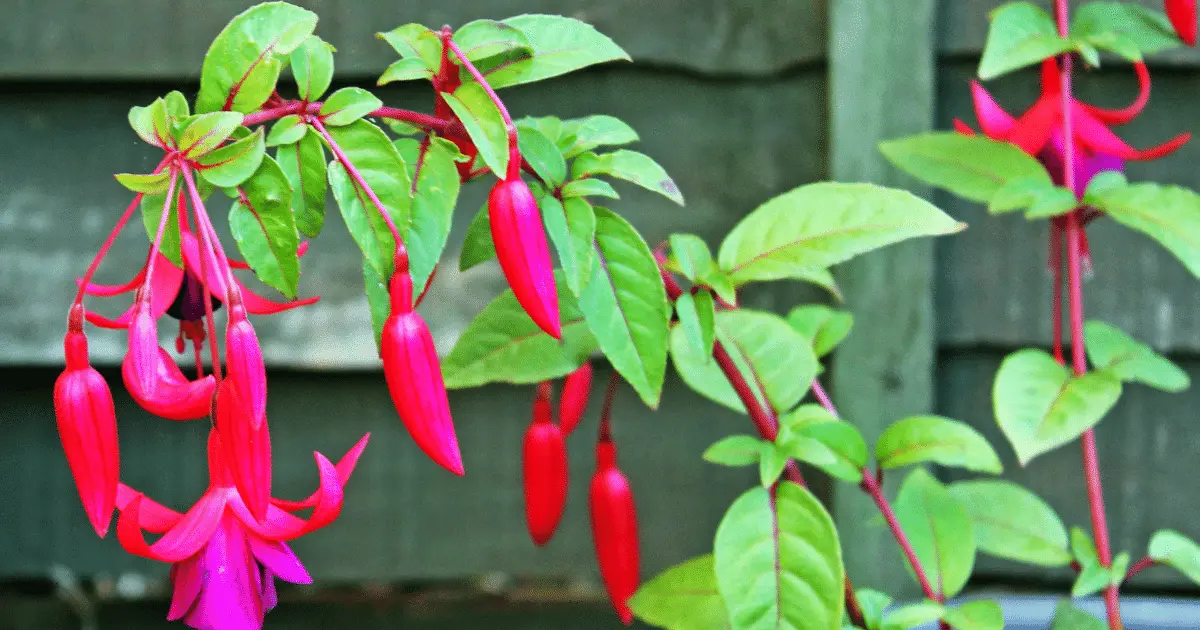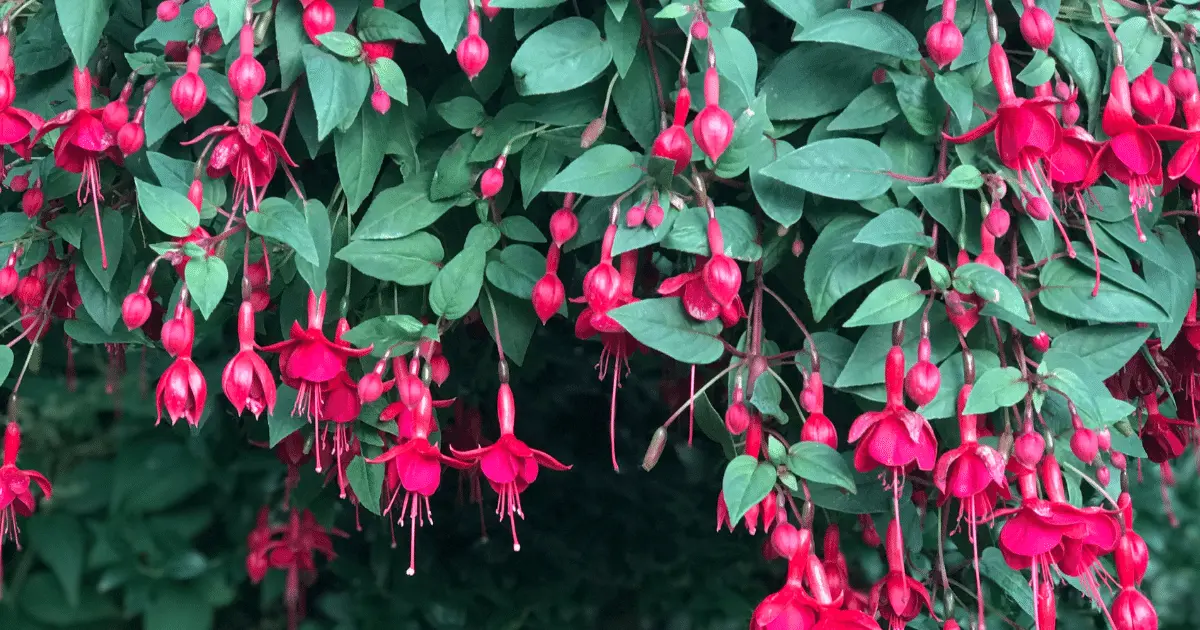The famous fuchsia plant is well known for its stunning, two-toned bell-shaped flowers. Fuchsias are considered low maintenance and thrive in gardens and containers; they are native to Central and South America.
Plant lovers love them for their stunning, profuse blooms, but if one doesn’t keep an eye on them, they can quickly begin to look run-down.
I brought mine back to life, and I’m here to give you tips to revive your beautiful fuchsia plant.
What Are the Factors That Cause Fuchsia Plants to Die?
Fuchsia plants need enough water to grow. The reason why your fuchsia is probably wilting is that it isn’t getting enough moisture. In the summer, your plant may require additional watering, typically twice daily, especially if it is sensitive to strong winds and excessive sunlight.
Another potential factor is overwatering. It may wilt if the plant receives too much water and has insufficient root drainage. When planting fuchsia plants, ensure there is at least one drainage hole to avoid this and ensure that the soil is well-drained.
Fuchsia plants are susceptible to viral ailments, including tomato spotted wilt and impatiens necrotic spot virus. Due to their ability to conceal themselves in blooms, buds, and other challenging-to-reach areas, destructive thrips are the cause of both of these viruses.
Another possible cause of wilting is exposure to too much sunlight. While some morning sunlight is appropriate, many plants cannot stand too much afternoon light.
How Can I Revive a Dying Fuchsia Plant?

Fuchsia flowers always make me think of gracefully twirling ballerinas hanging in the air at the ends of plant stems. Fuchsia is a common plant for hanging baskets and containers because of its lovely flowers. Fuchsia can lose the energy needed to produce blooms as its leaves drop, reducing its attractiveness. Your fuchsia plant may not produce leaves because of pests, cultivation, disease, or variety.
Fuchsia leaf drop is typically treatable or manageable; the plant can be brought to its former splendor. Follow these steps:
1. Not Enough Water
Let’s start with the most prevalent problem, shall we? Water is necessary for all plants, but fuchsias prefer a lot of it. They will wilt if left too dry for an extended period of time.
How will you know if this is the issue? Your plant needs moisture if the soil feels dry when you touch it. Most of the time, it’s that easy! In an ideal environment, the fuchsia plant would always have consistently moist soil that is neither overly wet nor dry and drains efficiently.
But things aren’t always perfect in the real world. We neglect to water, or perhaps there is a sudden dry spell.
A wilting fuchsia indicates that it needs more moisture. If this keeps happening, you might notice that the leaves start to yellow or that the tips of the leaves start to dry out and turn brown. Additionally, your plant might stop blooming.
Given how frequently this causes wilting, it’s a good thing that it can be treated quickly and easily.
Simply pour water into the soil until it is saturated, and water drips out of the holes in the bottom for potted plants. The soil should feel like a wet sponge for fuchsia growing in the ground. Within a few days, your treasured plant should begin to revive.
Additionally, hanging pots are especially prone to drying out. They’re suspended in the air, their tiny pots unprotected from the wind and light. On top of that, there isn’t a lot of soil around the roots because fuchsias are typically crammed in there pretty closely.
To keep these watered, you must exercise extra caution. The plant will not recover or partially recover if the roots are too dry for an extended period.
If your dry fuchsia doesn’t perk back up after 24 hours, try cutting back the stems by half and waiting to see if there are still enough healthy roots to support the now-smaller plant with water.
During warm spells, you may have to add water to hanging pots more than once a day. If you can’t commit to providing that much water or would rather err on the side of caution, consider putting them on the ground in a shaded area during the hottest period of the year.
2. Too Much Water
We already know that fuchsias enjoy the water. However, can be too much water. Standing water doesn’t do well for these plants. Check the soil before assuming a wilting plant needs water. If it feels wet, there’s no need to add more water.
Too much water is more than just giving a fuchsia plant more than it requires. Sometimes the issue is with soil being too compacted or having inadequate drainage.
Roots require oxygen. Even a small quantity of water can accumulate around the root system and kill them in soil that is too compact or poorly drained. Stop watering your plant if it is wilting and the ground feels moist.
Check if the foliage returns after allowing the soil to dry out for a day or two. If it does, cut back on the watering and test the soil before adding more.
However, if it doesn’t recover or the soil doesn’t dry out, you might need to enhance the soil’s situation. Take the entire plant out of the ground or container, and wash the dirt from the roots to reveal them.
Remove any roots that are soggy, transparent, black, or dead. Make sure the soil is well-draining before planting it again!
If you’re repotting your fuchsia plant in the same pot, it came in, make the container more porous and mix some rice hulls into the soil to help with drainage and moisture retention. Compared to perlite or vermiculite, rice hulls are a more affordable and environmentally friendly alternative.
Replanting in the ground requires a lot of well-rotted compost; alternatively, think about planting in a raised bed.
3. High Temperatures
Anyone can understand why fuchsias don’t want to be hot. Even if the soil is adequately moist, the foliage will droop if it gets too hot. Avoid adding moisture to the container or ground if this occurs! By soaking the roots in water, you run the risk of further taxing the plant.
Your fuchsia plant may suffer and wilt when temperatures soar into the mid-80s and above, mainly if the atmosphere is dry and the humidity is low. Before watering on a hot day, check the soil to see if too much heat is the problem.
Don’t add water if the soil is already wet. Instead, relocate any hanging plants you may have to a cool, shady area on the ground. Fuchsias in pots can also be moved to a more shaded location.
Spray some water on the foliage, then leave the plant in its shaded location to cool off until the weather improves. Once it has slightly cooled off, it ought to regain its vitality.
Check to ensure that fuchsias growing indoors are not being burned by the sun through a window. If they are exposed to direct sunlight during the hottest part of the day or an extended period of extreme heat, it is helpful to move the plants and mist the foliage.
Remember that soil can experience heat stress, whether moist or dry. Add water if the soil feels dry to the touch. If your plant doesn’t perk up, mist the leaves and move them to a cooler location.
4. Pest Infestation
If the watering situation is under control and the temperature isn’t too high, you may have to look closely at your plants to determine whether pests are bringing on the wilting issue.
This is less frequent, and if pests are to blame, you’ll typically notice other symptoms in addition to wilting and drooping.
Aphids, thrips, mites, and scales are just a few of the nasty creatures that fuchsia plants attract. If left unchecked, these pests can cause serious harm to plants.
There are two possibilities to consider if one wants to help pest-infested fuchsias recover. First, consider using beneficial insects as a cleanup crew by introducing pests that feed on aphids, mites, and scale. In this regard, natural insects like ladybugs excel, but plant parents must also take precautions to avoid developing a secondary insect infestation.
Instead, you could use insecticidal soap to treat fuchsias. Be sure to adhere strictly to the package instructions.
5. Diseased Fuschia
Your beloved flower friend most likely has a disease if the issue isn’t caused by pests or water.
Fuchsias can suffer irreparable damage from rust and gray mold. Due to this, it is advisable to regularly inspect your plants to ensure that the telltale symptoms of moldy stems and orange pustules are not present.
If either is present, the plant should be treated with fungicide immediately, and any diseased areas should be removed. Ensure there is enough airflow around the fuchsia and nothing is left underneath it.
Fuchsias can suffer harm from other viral and fungal conditions like verticillium wilt, root rot, and botrytis blight; stunted growth, spore masses, or discolored leaves are all warning signs that need to be taken seriously.
Early detection and treatment make a recovery from the disease much more likely. If not, eliminating and destroying the plant might be best to stop the infection from spreading.
How to Care for a Fuchsia Plant

Fuchsias are relatively simple to grow, but there are a few things to watch out for when caring for them. For starters, they ought to be planted in an area that receives both sun and some shade.
They can survive in slightly hotter or slightly cooler climates but thrive better between 55 and 80 degrees Fahrenheit. Regular watering is necessary, especially in the summer, and fuchsias prefer nutrient-rich, well-draining soil.
They can, however, be prone to rot, so be careful not to overwater them and unintentionally result in soggy roots.
These plants must be regularly inspected for insects, pests, and diseases that could harm or even kill them.
Frequently Asked Questions about How to Revive a Fuchsia Plant
What Bugs Are Good for Fuchsias?
If you’re thinking about adding pest-control insects to your fuchsias, look for creatures that eat the pests that frequently attack these lovely plants. Aphids and thrips are a favorite food for insects like ladybugs, lacewings, and pirate bugs.
How Often Should I Water My Fuchsias?
Checking the soil frequently to ensure it isn’t dry is the best way to find out. Fuchsias planted in the ground might only require watering once or twice a week, possibly more frequently in the summer. They will need more frequent watering in containers because pots don’t hold moisture, as well as garden beds do.
Will My Fuchsia Grow Back Next Year?
Although fuchsias are perennials, they are not cold-hardy, so you will need to overwinter them if you want them to come back year after year. Winter is not a time for fuchsias to bloom, so helping them go into dormancy will give them the best chance of returning the following year. They may appear dead at this point, but they are just resting before spring when they will return on their own.
Fuchsias have a very mystical and whimsical quality to them. They make an excellent choice for both expert and novice gardeners because they are so generous with their flowers and simple to care for. The best advice I can give you is to keep a close eye on them if you’re concerned that they’re nimble little things. They will always show signs before becoming ill.
